| Pages:
1
2 |
Fernando of Sor
Oud Addict
  
Posts: 29
Registered: 10-23-2011
Location: London, UK
Member Is Offline
Mood: Out of Tune
|
|
Rosettes - Tone Issues
Hi, I'm new to playing Oud. I notice that many oud players remove the rosettes form their soundholes. Exactly what effect does this have tonally? I
would guess there's an increase in volume, but how is the Bass/Treble balance effected ? Many Thanks - Mark
|
|
|
charlie oud
Oud Junkie
    
Posts: 694
Registered: 11-19-2007
Location: Newcastle upon tyne. UK
Member Is Offline
Mood: chords prefer frets
|
|
Hi Fernando, welcome to the forum.
Your question is an ongoing fascinating one. Personally, I have found that rosed ouds tend to provide a slightly more compressed sound, a little more
nasal which is a very classic tone. Unrosed sound to my ears is a little more open, more transparent if you get what I mean. I tend to hear slightly
more volume with unrosed ouds and even greater volume with floaters (floating bridge) but this is not a factor in sound 'quality'. I've not heard much
variation in bass & trebble when rosette is removed, its more that all registers of pitch are effected in the same way.
Moreover, it is largely a matter of opinion and not fact. The only fact on this subject is that a good quality oud sound is not dependant on a
rosette or its absence.
Best Wishes, Charlie
|
|
|
jdowning
Oud Junkie
    
Posts: 3485
Registered: 8-2-2006
Location: Ontario, Canada
Member Is Offline
Mood: No Mood
|
|
If you go to the topic 'Old Oud - New Project' (on page 5 of the Oud Projects forum) I report on a series of trials undertaken to try to measure the
acoustic effect of soundhole diameter as well as the effect with or without a rosette (page 10 of the topic).
Due to the large number of variables in the construction of an oud - no two instruments can be identical acoustically even if they appear to be alike
- these tests were carried out on a test instrument with modified sound hole to simulate different diameters etc.
It is well known that sound hole diameter relative to the volume of the instrument body cavity can be used to tune/enhance the loudness in the lower
registers (the, so called, Helmholtz effect) and so increase bass response. This was confirmed by the tests.
The tests also indicated that there is little or no difference in loudness between an open sound hole and one fitted with a rosette that is - as far
as the Helmholtz effect is concerned - the rosette diameter is equivalent to an open sound hole of the same diameter.
Interestingly, the presence of a rosette appeared to increase sustain compared to that obtained with open sound hole and also seemed to result in a
smoother attenuation (decay) of the sound vibrations so had some (small?) effect on the quality of sound.
An oud or any other musical instrument is a less than perfect Helmholtz resonator so attempts at precise analytical analysis in order to establish a
convenient formula to calculate design of an instrument with optimum acoustic response may likely always be in vain.
Nevertheless, the more successful luthiers throughout history seem to have, intuitively, 'got it right' one way or another (judging from the
variations in instrument size and geometry). One good reason, perhaps, for modern makers to follow the old established luthier traditions and
instrument designs?
|
|
|
stringmanca
Oud Junkie
    
Posts: 224
Registered: 8-4-2005
Location: Martinez, CA
Member Is Offline
Mood: Oud Moud
|
|
Interesting discussion! I had been wondering about this myself. Did your experiments include different rosette materials (wood vs. plastic vs.
bone)?
Thanks!
Nathan
|
|
|
jdowning
Oud Junkie
    
Posts: 3485
Registered: 8-2-2006
Location: Ontario, Canada
Member Is Offline
Mood: No Mood
|
|
The tests were done using sound hole inserts made from heavy bookbinder's card - 1.25 mm thick - to simulate different sound hole diameters and a
rosette. The card inserts were soaked in a hard oil varnish. The underside of the sound hole inserts were further reinforced with 3 mm thick card and
the underside of the rosette insert was further reinforced with small bars - normal practice for lute 'cut in' rosettes where the sound board area at
the rosette is only about 1mm thick (necessary to facilitate cutting the rose with knives and special chisels).
Oud rosettes (shams) are made from hard materials - solid or composite - and are made thick to be very stiff and so are equivalent to a lute
rosette.
On both lute and oud the sound board around the rosette is reinforced with at least two deep braces - sometimes with an additional brace (or braces)
of lesser depth running across the centre of the rosette. So the whole area around the sound hole is made structurally very rigid to minimise any
deflection of the rosette or sound hole when the sound board vibrates.
I still have the sound hole inserts used in the tests - see attached image.
I did not test alternative materials for the rosette but would be surprised if the material makes any significant difference acoustically - as long as
the material is hard and the rosette made very stiff.

|
|
|
stringmanca
Oud Junkie
    
Posts: 224
Registered: 8-4-2005
Location: Martinez, CA
Member Is Offline
Mood: Oud Moud
|
|
Thanks for the explanation!
|
|
|
Fernando of Sor
Oud Addict
  
Posts: 29
Registered: 10-23-2011
Location: London, UK
Member Is Offline
Mood: Out of Tune
|
|
Thanks - Fascinating - one more question...
Thanks, I've found all of this fascinating, one thing I was wondering was, if the rosette is made of fairly stiff material, how do you get it into the
sound hole? The rosettes in my Oud are plastic, with treble clefs in the design, which I think looks a bit cheap. I was considering either removing
them, or replacing them with better ones, how do they usually mount onto the soundhole? I get the feeling I'm asking a silly question here, so please
excuse my ignorance. Apart from that, many thanks for the very interesting responses, I'll check the other pages mentioned. Thanks - Mark (Fernando of
Sor)
|
|
|
jdowning
Oud Junkie
    
Posts: 3485
Registered: 8-2-2006
Location: Ontario, Canada
Member Is Offline
Mood: No Mood
|
|
The rosettes are glued in place before the sound board is fitted.
|
|
|
Alfaraby
Oud Junkie
    
Posts: 796
Registered: 9-18-2009
Location: Holy Land
Member Is Offline
Mood: Cool
|
|
I've successfully done this several times :
Removing the old rosette : wet a sharp knife with thinner and ease in between the soundboard & the rose. It shall be gradually
detached and easily removed.
Inserting the new rosette : cut the frame in two opposite points and ease the soundboard in each cut respectively. After dropping
inside the oud, tie the rose with an old string or a strong thread, glue the frame & the inside of the soundboard with contact glue & firmly
attach them together for ten minutes or so.
Hoping this poor description would help a bit 
Yours indeed
Alfaraby
|
|
|
charlie oud
Oud Junkie
    
Posts: 694
Registered: 11-19-2007
Location: Newcastle upon tyne. UK
Member Is Offline
Mood: chords prefer frets
|
|
I dont think the rosette is placed before sound board is fitted. In the following clip the fitting of the rosette is at 4min 39 sec. The clip is from
Al oud which is an excellent documentary film available from amazon.de.
http://www.youtube.com/watch?v=VCop5dj8WAo&feature=results_vide...
Best Wishes, Charlie
|
|
|
jdowning
Oud Junkie
    
Posts: 3485
Registered: 8-2-2006
Location: Ontario, Canada
Member Is Offline
Mood: No Mood
|
|
The clip shows the rosette being glued into position - held in place with string and a 'strong back' - but does not show how the rosette happens to be
inside the bowl. Was it placed in the bowl (loose) before the sound board was glued in place - if so why? What is the advantage when it is much easier
to glue the rosette in place before the sound board is attached?
For repairs, a rosette may be unglued to allow access for internal repairs that are possible through the sound hole and it can be re-glued using this
string and 'strong back' clamping method.
Alfaraby describes the above repair method as well as a procedure for inserting a new rosette into the bowl by cutting " the frame in two opposite
points" and by easing " the sound board in each cut respectively" but I am not sure what is meant by "the frame" or how the sound board is "eased in
each cut".
As this is an interesting repair method that might answer Mark's question about replacing the rosette on his oud perhaps Alfaraby could clarify his
technique with some additional detail?
Some oud rosettes are attached in such a way that they can only be glued in place before the sound board is attached. For example I have an old oud
fitted with two short support braces on each side of the centre of the rosette that are notched to fit over the rosette and so must have been glued in
place after the rosette had been fitted and - so - before the sound board had been attached. This arrangement makes it impossible to remove the
rosette for repairs through the sound hole - as described above.
I shall post a couple of images to follow for clarity.
|
|
|
jdowning
Oud Junkie
    
Posts: 3485
Registered: 8-2-2006
Location: Ontario, Canada
Member Is Offline
Mood: No Mood
|
|
The attached images show how the short side braces on my old oud are notched and glued over the rosette making removal of the rosette impossible
without first removing the sound board.
A traditional technique perhaps - but best not followed if future repairs through the sound hole are anticipated!
However, sound board removal for repairs was once a past standard practice and no 'big deal' for a luthier. But then hot hide glue was used to attach
the sound board - easily reversible unlike modern adhesives.
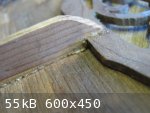
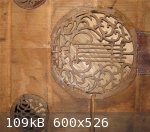
|
|
|
Fernando of Sor
Oud Addict
  
Posts: 29
Registered: 10-23-2011
Location: London, UK
Member Is Offline
Mood: Out of Tune
|
|
HI again. Thanks Charlie, that's a great clip, I'll certainly be getting a full version of that at some point.
If I understood Alfaraby correctly, then he's talking about cutting the rosette down the middle, inserting each half into the body, through the
soundhole, and then carefully glueing the two halves back together once inside the body, simultaneously attaching it to the underside of the sound
hole surround. This is exactly what I was thinking to do myself. I'm a carpenter by trade, certainly not as skilled as a luthier, but I do furniture
repairs, and have carried out work on my own acoustic and electric guitars. I think it would work, but it would need a very good quality, thin saw and
a steady hand. Thanks Alfaraby.
I suppose, as with most things, there's more than one way.
Jdowning, you clearly know your stuff, do you build complete insruments? The information you've provided in these posts has been very helpful.
Many thanks to all.
|
|
|
Alfaraby
Oud Junkie
    
Posts: 796
Registered: 9-18-2009
Location: Holy Land
Member Is Offline
Mood: Cool
|
|
It's my ill technical background & skills that caused this misunderstanding.
My technical English is even poorer, so please excuse me.
By saying cut the frame I meant cut the circumference of the round rose at two points as shown in the image bellow. By saying ease the SB in the cuts
I meant now when you have the rose cut as said & shown, you may insert the SB in the first slot of the rose, then in the second . Now the rose is
inside the sound box & you may proceed with gluing as mentioned before. I advise using contact or hot adhesive for future need to remove the glued
rosette.
I'm not sure this explanation has clarified the point or any part of it.
So please excuse me, once again.
As to the "sealing" of the rosette as mentioned, it's a known pattern of Nahat family to prevent any malicious messing with their masterpieces. In
this case, there shall be no way but taking off the SB.
Yours indeed
Alfaraby
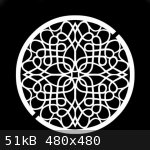
|
|
|
charlie oud
Oud Junkie
    
Posts: 694
Registered: 11-19-2007
Location: Newcastle upon tyne. UK
Member Is Offline
Mood: chords prefer frets
|
|
Alfaraby's picture above is shows it all. This is how it is on my Sukar oud (it had a rosette but I removed it) . Mine has a single 6mm slot cut on
the edge so you can ease the edge of the rosette into the bowl area by allowing the the slotted part of the rosette to be filled by the edge of the
soundhole. This reduces the circumference enough for most of the rosette to enter the bowl area. You then unslot the rosette inside the bowl. THE
ROSETTE MUST HAVE A PIECE OF STRING OR WIRE ATTATCHED TO IT BEFORE YOU DO ALL THIS. Next you place your glue on the edge of the and pull it up into
place and secure it until dry, as in the clip I posted above from the Al oud movie.
Best Wishes, Charlie
|
|
|
littleseb
Oud Junkie
    
Posts: 224
Registered: 10-14-2008
Location: london - uk
Member Is Offline
Mood: high
|
|
interesting thread.
time for me to ask a daft question - how come rosettes are never seen on ouds with oval sound holes? or do they exist? i've never seen one, but always
thought it could look quite stylish...
also - if the rosette really changes the sound of the oud for the better or worse, could one design a removable rosette, so that the sound of the oud
can be altered quickly, according to preference?
|
|
|
jdowning
Oud Junkie
    
Posts: 3485
Registered: 8-2-2006
Location: Ontario, Canada
Member Is Offline
Mood: No Mood
|
|
Thanks for the clarification Alfaraby - that is now perfectly clear. Neat!
Charlie oud beat me to it but - dependent upon the design of a rosette - only one 'V' cut should be necessary on one side - perhaps even with a small
'flat' cut on the opposite side to give extra clearance through the sound hole if required. The attached 'cut and paste' images show the insertion of
the rosette in stages.
As Alfaraby notes a more complex rosette design would not lend itself to this technique although on a new oud the rosette could be placed, loose,
inside the bowl (no modification required to the rosette) prior to gluing on the sound board.
So then it would seem that a luthier has an option to glue in the rosette after fitting the sound board - dependant upon the design (not possible in
some cases) but the question of why this more complicated procedure would be an advantage over gluing the rosette in place before sound board
installation remains.
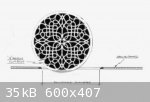
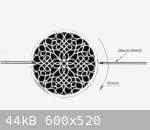
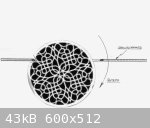
|
|
|
charlie oud
Oud Junkie
    
Posts: 694
Registered: 11-19-2007
Location: Newcastle upon tyne. UK
Member Is Offline
Mood: chords prefer frets
|
|
Yes John, it does seem a bit complicated, why not place the rose in the bowl and glue after soundboard is fitted or even glue rosette before fixing
soundoard to bowl. I guess its because Roses on ouds can come loose and need to be removeable. Lute makers carve the rose as part of the soundboard.
I've never understood why Oud makers never do this. I agree that only 1 slot is required and yes a 'V' will make it easier.
Seb, there are many ouds with oval rosettes they're not as common as round rosettes. Theyre found mostly on Iraqi ouds I think, though someone may
correct me on this.
Best Wishes, Charlie
|
|
|
Alfaraby
Oud Junkie
    
Posts: 796
Registered: 9-18-2009
Location: Holy Land
Member Is Offline
Mood: Cool
|
|
See this :
http://m.youtube.com/index?desktop_uri=%2F&gl=IL#/watch?v=XmlzE...
I myself have an oval roses oud. See attached bellow .
Oud : Hassan Belhaiba, Morocco. Rosette: designed & assembled by: yours truly !
Yours indeed
Alfaraby
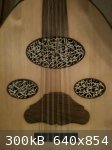
|
|
|
jdowning
Oud Junkie
    
Posts: 3485
Registered: 8-2-2006
Location: Ontario, Canada
Member Is Offline
Mood: No Mood
|
|
Charlie - the only exception to a glued rosette for an oud that I can recall is the old 4 course Tunisian 'oud arbi' where the triple rosette is cut
directly into the sound board like a lute. As the 'oud arbi' may be a direct descendant of the mediaeval period ouds (?) - as, supposedly, were
European lutes - it is possible that at one time oud rosettes were 'cut in'.
Checking a few 'oud building' videos 'on line' it would seem that for triple rosette ouds only the main rosette is made to be glued after the sound
board has been fitted in place (where applicable). The two small rosettes always appear to be glued in place before the sound board is fitted.
If oud rosettes tend to come unglued over time I have to wonder if this is a consequence of gluing the rosette after the sound board has been fitted -
it being more difficult to apply a sufficient and uniform clamping force to the rosette (using string and a 'strong back') when gluing it in place?
Also this method likely requires a slow setting (modern synthetic?) glue and so would mean that traditional, fast gelling, hide glue would be
unsuitable for the purpose. This may, in turn, suggest that this method is not traditional but a fairly recent idea only made possible by modern
synthetic adhesives?
If the rosette is glued prior to sound board installation - effectively clamped in place with woodworking clamps - and using hot hide glue, it is hard
to imagine that the rosette, fitted this way, would ever become unglued in service - although, of course, it could easily be removed at any time with
moisture and heat just like a sound board.
|
|
|
Fernando of Sor
Oud Addict
  
Posts: 29
Registered: 10-23-2011
Location: London, UK
Member Is Offline
Mood: Out of Tune
|
|
Brilliant.
Ok, now I understand, clever stuff!
I have alot to learn....
|
|
|
jdowning
Oud Junkie
    
Posts: 3485
Registered: 8-2-2006
Location: Ontario, Canada
Member Is Offline
Mood: No Mood
|
|
One final thought. Perhaps those oud makers who choose to fit the rosette after installing the sound board do so to provide access (through the open
sound hole) for clamps that they need to glue the bridge in place?
This is a technique used by classical guitar builders but one, of course, that cannot be used by oud builders who fit the rosette prior to installing
the sound board (or by lute makers where the rosette is 'cut in').
|
|
|
charlie oud
Oud Junkie
    
Posts: 694
Registered: 11-19-2007
Location: Newcastle upon tyne. UK
Member Is Offline
Mood: chords prefer frets
|
|
John, you pose some good open questions and forward sound explanations. It would be good if some makers joined this thread. Personally having played
the European lute for some years, I still remain baffled that over 600 yrs ago the makers were carving roses out of the soundboard yet this practice
is not at all common in oud making. For fear of sounding discriminatory, and with hesitation, I wonder if it is because it is simply easier to carve a
seperate rose?
Best Wishes, Charlie
|
|
|
jdowning
Oud Junkie
    
Posts: 3485
Registered: 8-2-2006
Location: Ontario, Canada
Member Is Offline
Mood: No Mood
|
|
I have been making (and playing) lutes since the early 1970's so have first hand experience in making traditional design 'cut in' lute rosettes.
Lute rosettes are made using very simple tools - sharp knives and chisels - to first pierce the rosette pattern through the sound board and then to
emboss the front of the rosette with chip carving. It is pains-taking work that takes me about a day to complete from start to finish without any need
to rush.
The thicker oud rosettes on the other hand are cut by hand with a fine jeweller's piecing saw or by machine on a jig saw (they are not carved).
Compared to cutting a traditional lute rosette, complex and delicate as it is, sawing an oud rosette must be even more exacting and time consuming
work - dependent, of course, upon the complexity of the design. Indeed some of the early Nahat rosettes are so intricate to be seemingly impossible to
execute by mere mortals!
I am not sure when the fine saw blades required to cut oud rosettes were first invented - probably much earlier than the mid 16th C proposed by some
sources - but, no doubt, 'cut in' rosettes for ouds historically came before the sawn fretwork oud rosettes that are the norm today and were
contemporary with those of the lute in the 16th/17th C.
Of course, what may be a relatively simple task for one person may be impossibly difficult for another - it all depends upon one's level of manual
skills.
|
|
|
jdowning
Oud Junkie
    
Posts: 3485
Registered: 8-2-2006
Location: Ontario, Canada
Member Is Offline
Mood: No Mood
|
|
A third type of rosette arrangement can be found on an old Egyptian oud - #0164 in the Brussels Musical Instrument Museum. This may be one of the
oldest surviving ouds dating to the late 18th C (?).
It has a triple rosette with two small sound holes set 'unusually' close to the main sound hole so that there does not appear to be sufficient space
to fit a brace between them.
The rosette pattern is a very ancient design - the so called 'Flower of Life' - dating back at least 3000 years. The design lends itself to being
pierced directly with chisels (not sawn) - like a lute rosette. However, although from the image the rosette seems to be 'cut in' like that of a lute,
it has been confirmed by museum curator Saskia Willaert that the rosettes are in fact made separate from the sound board and are inset flush with the
sound board surface.
No further details are available about the rosette arrangement but it might be concluded that the rosette is the same thickness as the sound board
(about 1.5 mm (?) without further reinforcement(?) and is glued to some kind of 'support' that could be either a continuous ring or a series of small
wooden blocks that form a ledge under the sound hole - as shown in the attached sketch.
In theory this type of inset rosette could be removed - for whatever reason.
The #0164 oud is discussed in more detail under the topic 'Old Oud compared to Old Lute Geometry' (page 2) on this forum.
Note that the brace on the bridge side of the main sound hole - according to current assumptions - may be placed 'unusually' below the small sound
holes.
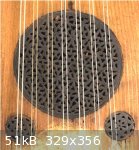


|
|
|
| Pages:
1
2 |